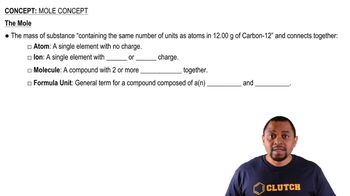The complete combustion of methane, CH4(g), to form H2O(l) and CO2(g) at constant pressure releases 890 kJ of heat per mole of CH4. (a) Write a balanced thermochemical equation for this reaction.
Atomic hydrogen (H) is used in welding (AHW). The atoms recombine to hydrogen molecules with a large release of heat according to the following reaction: 2 H(g) → H2(g) (a) Using the thermodynamic data in Appendix C, calculate the enthalpy change for this reaction per mole of H2.
 Verified step by step guidance
Verified step by step guidance
Verified video answer for a similar problem:
Key Concepts
Enthalpy Change

Thermodynamic Data

Mole Concept

The complete combustion of methane, CH4(g), to form H2O(l) and CO2(g) at constant pressure releases 890 kJ of heat per mole of CH4. (b) Draw an enthalpy diagram for the reaction.
The decomposition of sodium bicarbonate (baking soda), NaHCO3(s), into Na2CO3(s), H2O(l), and CO2(g) at constant pressure requires the addition of 85 kJ of heat per two moles of NaHCO3. (a) Write a balanced thermochemical equation for the reaction.
Atomic hydrogen (H) is used in welding (AHW). The atoms recombine to hydrogen molecules with a large release of heat according to the following reaction: 2 H(g) → H2(g) (b) Which has the higher enthalpy under these conditions, 2 H(g) or H2(g)?
Without referring to tables, predict which of the following has the higher enthalpy in each case: (a) 1 mol I2(s) or 1 mol I2(g) at the same temperature
Without referring to tables, predict which of the following has the higher enthalpy in each case: (b) 2 mol of iodine atoms or 1 mol of I2
